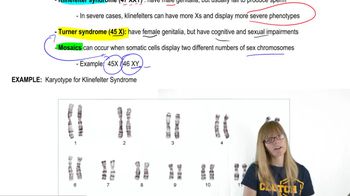Table of contents
- 1. Introduction to Genetics51m
- 2. Mendel's Laws of Inheritance3h 37m
- 3. Extensions to Mendelian Inheritance2h 41m
- 4. Genetic Mapping and Linkage2h 28m
- 5. Genetics of Bacteria and Viruses1h 21m
- 6. Chromosomal Variation1h 48m
- 7. DNA and Chromosome Structure56m
- 8. DNA Replication1h 10m
- 9. Mitosis and Meiosis1h 34m
- 10. Transcription1h 0m
- 11. Translation58m
- 12. Gene Regulation in Prokaryotes1h 19m
- 13. Gene Regulation in Eukaryotes44m
- 14. Genetic Control of Development44m
- 15. Genomes and Genomics1h 50m
- 16. Transposable Elements47m
- 17. Mutation, Repair, and Recombination1h 6m
- 18. Molecular Genetic Tools19m
- 19. Cancer Genetics29m
- 20. Quantitative Genetics1h 26m
- 21. Population Genetics50m
- 22. Evolutionary Genetics29m
7. DNA and Chromosome Structure
Eukaryotic Chromosome Structure
Problem 4a
Textbook Question
Describe the importance of light and dark G bands that appear along chromosomes.
 Verified step by step guidance
Verified step by step guidance1
Understand that G-banding is a technique used in cytogenetics to produce a visible karyotype by staining condensed chromosomes.
Recognize that the 'G' in G-banding stands for Giemsa, a dye used to stain the chromosomes.
Identify that light and dark G bands correspond to different regions of the chromosome: light bands are generally less condensed and more transcriptionally active, while dark bands are more condensed and less transcriptionally active.
Acknowledge that G-banding helps in identifying chromosomal abnormalities, such as deletions, duplications, and translocations, by providing a distinct pattern for each chromosome.
Appreciate that the banding pattern is unique for each chromosome, allowing for the identification and differentiation of individual chromosomes within a karyotype.
Recommended similar problem, with video answer:
 Verified Solution
Verified SolutionThis video solution was recommended by our tutors as helpful for the problem above
Video duration:
3mPlay a video:
Was this helpful?
Key Concepts
Here are the essential concepts you must grasp in order to answer the question correctly.
Chromosome Structure
Chromosomes are long strands of DNA wrapped around proteins called histones, forming a compact structure that is essential for DNA packaging during cell division. Each chromosome has distinct regions that can be stained to reveal patterns, which are crucial for identifying specific chromosomes and their abnormalities.
Recommended video:
Guided course

Chromosome Structure
Giemsa Staining
Giemsa staining is a technique used to visualize chromosomes under a microscope. This method highlights specific regions of chromosomes, creating light and dark bands (G bands) that reflect the underlying DNA sequence and chromatin structure, allowing for the identification of chromosomal abnormalities and genetic disorders.
Karyotyping
Karyotyping is the process of pairing and arranging chromosomes in a standard format to analyze their number and structure. The distinct G banding patterns are essential for karyotyping, as they help in identifying chromosomal abnormalities such as deletions, duplications, or translocations that can lead to genetic diseases.
Recommended video:
Guided course

Human Sex Chromosomes

 7:10m
7:10mWatch next
Master Chromosome Structure with a bite sized video explanation from Kylia Goodner
Start learningRelated Videos
Related Practice


